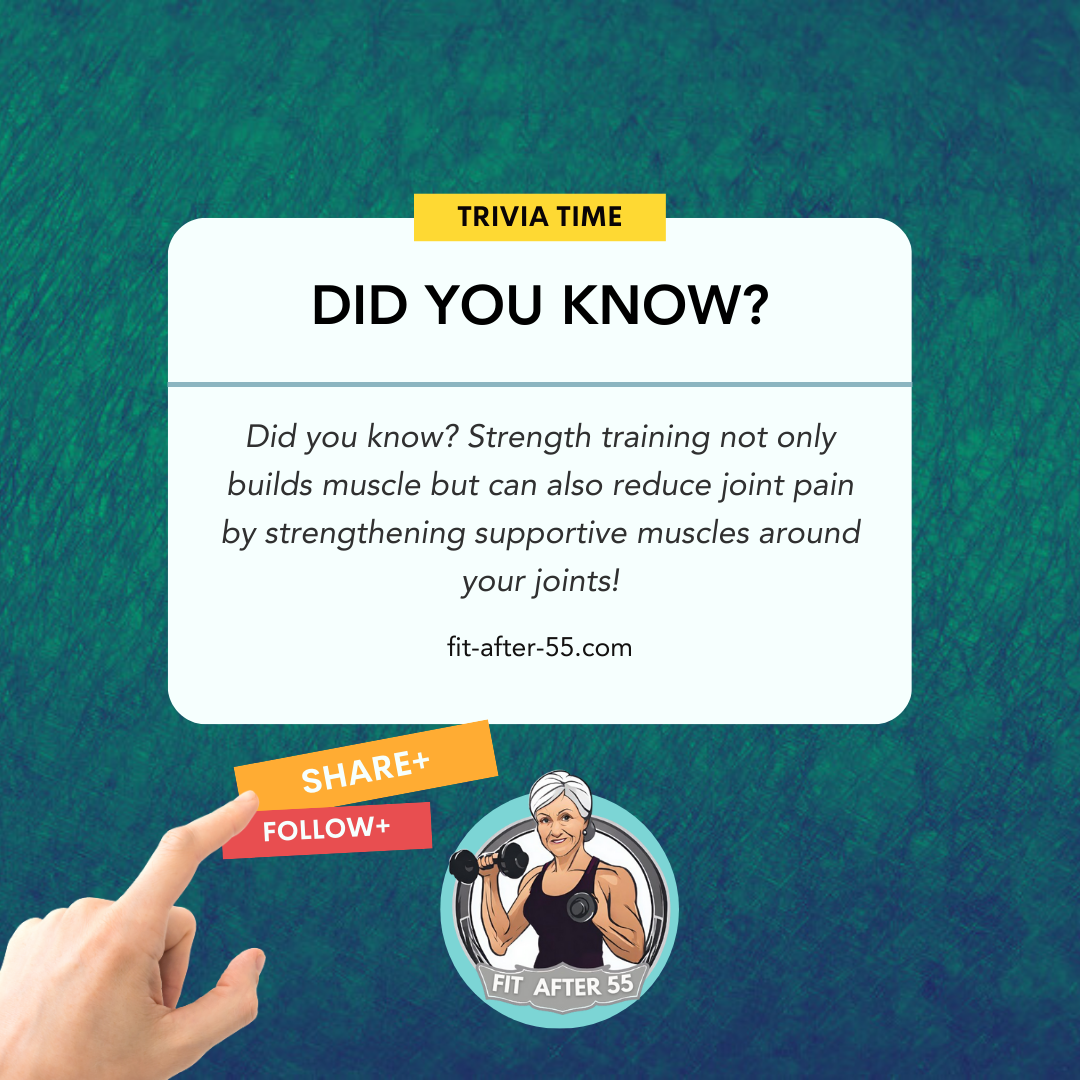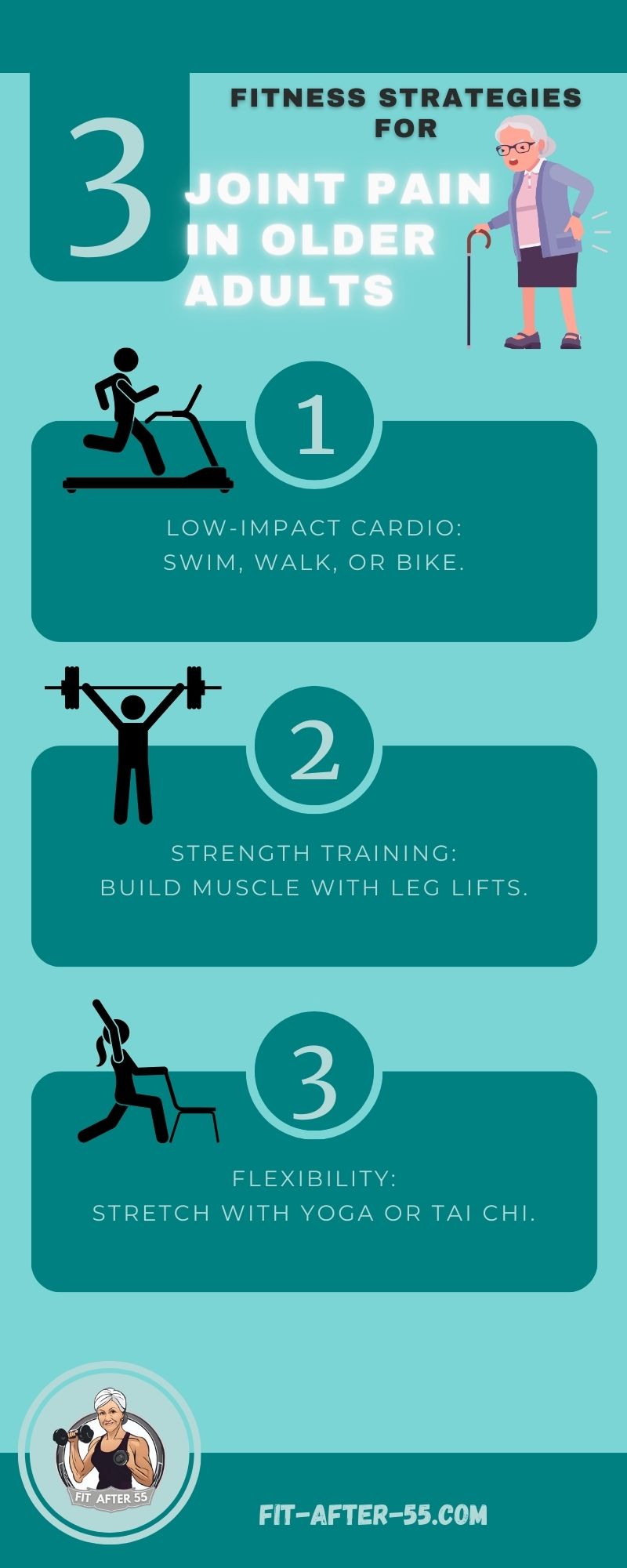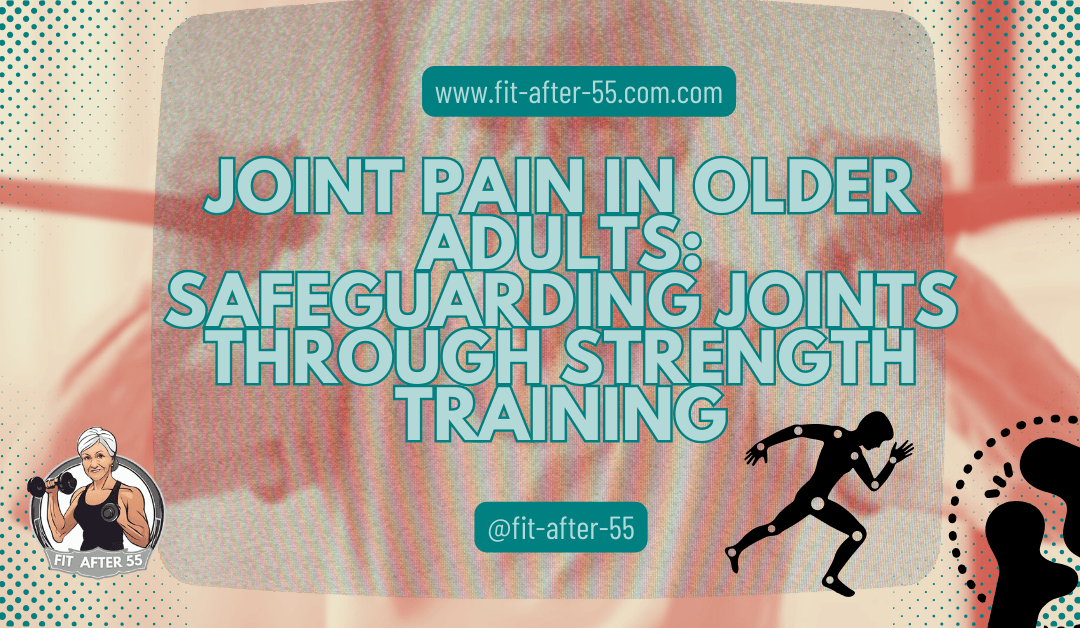Maintaining joint health and mobility are crucial for longevity and quality of life, especially as you age. For older adults experiencing joint pain, strength training can be a formidable tool to improve overall joint function and reduce discomfort. Though the idea of lifting weights might seem daunting if you’re managing soreness, the right approach to strength training can actually help alleviate joint pain rather than exacerbate it. By increasing muscle strength around vulnerable joints, you provide better support and can potentially reduce the burden on your joints, leading to improved mobility and a decrease in pain.

Joint Pain in Older Adults: Crafting Joint-Friendly Strength Training Routines
To embark on a strength training regimen that’s kind to your joints, it is essential to arm yourself with knowledge that allows for safe and effective workouts. Selecting appropriate exercises, using the right equipment, and understanding how to structure your routine are all factors that contribute to the success and sustainability of your strength training efforts. Importantly, acknowledging and integrating rest, proper nutrition, and collaborating with healthcare providers can optimize your results and safeguard your joint health as you strengthen your body.
Key Takeaways
-
-
- Strength training can alleviate joint pain and improve mobility for older adults.
-
-
- Employing the correct techniques and equipment is essential for protecting joints during exercise.
-
- Integrating rest and consulting with healthcare professionals are key to sustainable strength training.
Understanding Joint Pain in Older Adult
Joint pain in older adults is often the outcome of arthritis, a term covering several conditions affecting the joints. The two main types of arthritis are:
-
-
- Osteoarthritis (OA): This is the wear-and-tear that occurs when your joint’s cartilage deteriorates with age.
-
-
- Rheumatoid Arthritis (RA): An autoimmune disease in which your immune system mistakenly attacks the joints.
Factors contributing to joint pain include:
-
- Age: The risk of developing arthritis increases as you age due to the wear on joints over time.
-
-
- Muscle Weakness: Lack of muscle strength can put more pressure on the joints.
Pain, stiffness, and swelling are common symptoms you might experience. Your pain may be constant or it could fluctuate, potentially worsening with activity.
Understanding which type of arthritis you have is crucial, as it may affect your treatment options. Regular low-impact exercises, such as swimming or yoga, can help maintain joint function and relieve stiffness.
Remember, it’s important to consult a healthcare provider to devise an exercise plan tailored for your needs. They can help you understand your joint pain and recommend the appropriate activities and intensity levels.

Benefits of Strength Training for Joint Health
Strength training can be a powerful tool in managing joint health, specifically for older adults battling joint pain. Let’s explore how resistance exercises can play a pivotal role in supporting your joint function.
Improves Muscle Support
By integrating strength training into your routine, you actively enhance the muscular stability around your joints. This is crucial for joint support as strong muscles help in mitigating the load and stress applied to the joints, which, in turn, can alleviate pain and prevent further joint deterioration.
Enhances Mobility
Regular strength training can lead to significant improvements in your range of motion and overall mobility. When your muscles are stronger and more flexible, you’re able to move more freely, which not only contributes to the ease of daily activities but also supports joint health by keeping them actively engaged and less prone to stiffness.
Reduces Pain Sensation
Strength training can alter the way your body perceives pain by increasing your pain threshold. As you strengthen the muscles around painful joints, you might notice a reduction in the intensity of pain you experience, making your day-to-day tasks less challenging and improving your quality of life.

Safe Strength Training Techniques
Adopting safe strength training techniques ensures that you can enjoy the benefits of exercise while minimizing the risk of aggravating joint pain. Focus on methods that protect your joints and build strength at a comfortable pace.
Low-Impact Exercises
Choose low-impact exercises that have a minimal chance of stressing your joints. Options like swimming, water aerobics, and stationary cycling are ideal. For strength training, resistance bands can offer adjustable tension while minimizing impact.
-
-
- Swimming: Provides resistance with very low impact on joints.
-
-
- Resistance Bands: Offer a full range of motion and variable resistance levels.
Proper Warm-Up Routines
Before beginning your strength training session, engage in a proper warm-up routine to prepare your muscles and joints. A warm-up could include dynamic stretching or a short walk to increase blood flow to the muscles and reduce the risk of injury.
-
-
- Dynamic Stretching: Engage in movements that mimic your workout routine.
-
-
- Short Walk: A 5 to 10-minute brisk walk can serve as an effective warm-up.
Use of Correct Posture
Maintaining correct posture during exercises is crucial to prevent strain on your joints. Keep your spine neutral and use mirrors or a personal trainer to check your alignment. When lifting weights, ensure you’re using a smooth and controlled motion.
-
-
- Spinal Alignment: Keep your spine in a neutral position throughout the exercise.
-
-
- Controlled Motions: Perform each exercise with slow, deliberate movements to maintain proper form.
Equipment Choices for Joint Protection

Selecting the right equipment can help you manage joint pain while engaging in strength training. These tools are designed to reduce stress on your joints, ensuring a safer and more comfortable workout experience.
Supportive Footwear
Shoes with adequate cushioning and support can make a substantial difference in protecting your joints from the impact associated with exercise. Look for footwear that provides a stable base and enhances your balance during strength training.
Assistive Devices
Resistance bands are excellent for maintaining muscle strength with minimal joint strain. They come in various resistance levels, often color-coded, to match your fitness level and can be used for a range of exercises to target different muscle groups.
Free weights and weight machines can offer controlled resistance training; however, for those with arthritis, machines may be preferable as they help maintain proper form and distribute the load more evenly across your joints.
Protective Gear
Wearing gloves can improve grip and comfort while reducing the pressure on hand joints during exercises like weightlifting. Knee and wrist wraps provide additional joint stability and can help alleviate pain by applying pressure and supporting joint alignment.
Creating a Personalized Workout Plan
Before diving into your strength training routine, it’s essential to create a plan that caters to your unique needs, especially when managing joint pain. A personalized workout plan must start with expert advice, include realistic objectives, and allow for gradual progress.
Assessment by a Professional
Begin your journey with an assessment by a healthcare or fitness professional. They will evaluate your current fitness level, flexibility, and pain points to tailor exercises that minimize joint stress. For instance, if you experience knee pain, a professional can suggest a knee-friendly workout routine.
Setting Realistic Goals
Your goals should be clear, measurable, and achievable. Whether it’s being able to climb stairs without pain or improving endurance, your objectives will guide the structure of your workout. Resist the temptation to set high bars; rather, aim for steady and maintainable improvements over time.
Gradual Progression
Incorporate a gradual progression approach to avoid overexertion and reduce the risk of injury. Start with light weights or bodyweight exercises before slowly adding more resistance. Balance and flexibility exercises are also vital—such as those outlined in the strength training guide for older adults. Regularly assess and adjust your routine to align with your increasing strength and endurance.

Managing Soreness and Pain
When engaging in strength training, it’s crucial to address the discomfort and soreness that may arise, especially in joints. Implementing the right techniques can alleviate pain and improve your exercise experience.

Applying Heat or Cold
Using heat can relax your muscles and enhance blood flow, which is beneficial before beginning your workout. Conversely, cold packs can reduce inflammation and numb sore joints post-exercise. Use a heating pad or warm towel for heat application, and a cold gel pack or a bag of frozen vegetables wrapped in a cloth for cold.
Balancing Activity and Rest
Alternate between periods of activity and rest to prevent overworking your joints. Plan your workout schedule to allow for recovery time, and listen to your body to determine the optimal balance.
Anti-Inflammatory Measures
Incorporate anti-inflammatory foods such as omega-3-rich fish and leafy greens into your diet. Over-the-counter non-steroidal anti-inflammatory drugs (NSAIDs), like ibuprofen, can also be used to manage joint pain, but always consult with your healthcare provider before starting any medication.
Nutrition and Supplementation for Healthy Joints
To maintain joint health as you age, it’s crucial to incorporate specific nutrients into your diet, stay well-hydrated, and consider the appropriate supplements.
Essential Nutrients
Your joints require a range of vitamins and minerals to function optimally. Ensure you’re getting enough Vitamin D for bone health, Vitamin C for collagen production, and calcium to support bone structure and function. Sources of these could be fortified dairy products for calcium and citrus fruits for Vitamin C. Omega-3 fatty acids, found in fish like salmon, can help reduce joint inflammation.
Hydration
Keep your joints lubricated by drinking plenty of water. Adequate hydration can help maintain the elasticity of joint tissues. Aim for at least 8 glasses of water daily, especially before and after exercise.
Joint Supplements
Consider adding supplements like glucosamine and chondroitin to your regimen, though results vary individually. These can potentially support joint cartilage and reduce pain. However, it’s wise to consult your healthcare provider before starting any new supplement.
Monitoring Progress and Adjusting Strategies

When you embark on a strength training program, keeping track of your progress is crucial. Start by setting clear and measurable goals. For instance, your objectives could be increasing the weight you lift by 10% or extending your workout duration by five minutes.
As you proceed, maintain a workout log. In this log, you should note:
-
- Exercises performed
-
-
- Sets and repetitions
-
- Weights used
-
- Levels of joint pain before and after exercise
Use technology to your advantage. Pedometers, activity trackers, or even simple apps can evaluate and monitor your progress. These tools provide objective data, such as the number of steps taken daily, which can be a powerful motivator.
Reassessment should be periodic. For example, every four to six weeks, review your log and data from any activity trackers. This review helps identify patterns or improvements and inform necessary adjustments to your routine.
Listen to your body closely for signs of excessive strain, fatigue, or pain, and be prepared to adapt. If certain movements cause discomfort, substitute with others that feel more comfortable. Lean on professional guidance when making these adaptations.
Remember, strength training is not a sprint, but rather a marathon with your well-being as the finish line. Your program should reflect your evolving capabilities and limitations, ensuring you can continue to train effectively while managing joint pain.
Collaborating with Healthcare Providers
When embarking on strength training to manage joint pain as an older adult, it is crucial to work in tandem with healthcare professionals. Your team may include a range of experts from physicians to physical therapists. Here’s how you can effectively collaborate with them:
-
-
- Communicate Your Goals: Be clear and articulate about your objectives. Whether you wish to alleviate knee pain or improve overall mobility, your providers can tailor a program to suit these goals.
-
-
- Understand Your Condition: Ask your healthcare provider to explain your joint pain and any related conditions such as arthritis. By understanding your medical condition, you can better appreciate the importance of specific exercises and their modifications to avoid aggravation.
-
- Seek Guidance on Exercises: Engage with a physical therapist to learn appropriate strength training exercises that will benefit your joints without causing additional pain or harm. This may include:
-
- Low-impact exercises: These protect your joints while strengthening your muscles.
-
-
- Balance and coordination training: Essential for preventing falls and maintaining independence.
-
- Seek Guidance on Exercises: Engage with a physical therapist to learn appropriate strength training exercises that will benefit your joints without causing additional pain or harm. This may include:
-
- Monitor Progress: Convey any changes in your pain levels or mobility to your healthcare provider. Adjustments to your training regimen may be necessary based on their expert assessment.
| Key Professional | Role in Your Training |
|---|---|
| Physician | Oversees your overall health; offers advice on safe exercise limits. |
| Physical Therapist | Designs customized exercise plans; provides technique instructions. |
| Occupational Therapist | Suggests modifications to assist with daily activities. |
Remember, consistent interaction and feedback with your healthcare team can lead to a more effective, safer exercise experience that is aligned with your health status and fitness aspirations.
Incorporating Rest and Recovery
When engaging in strength training, it is crucial that you allow your body adequate time to rest and recover, especially if you’re managing joint pain. Recovery time is not merely a break from your workout routine; it is a period during which your muscles repair and strengthen. Therefore, striking a balance between exercise and rest is fundamental.
Prioritize Sleep: Your muscles require sleep to recover from the strain of exercise. Aim for 7-9 hours of quality sleep per night.
Listen to Your Body: If you experience an increase in joint pain or general fatigue, it might be a signal to rest. Pushing through pain can lead to injury or exacerbate existing conditions.
Plan Recovery Days: Schedule days with no or low-intensity activity into your workout regimen. This intentional scheduling helps prevent overexertion.
Hydrate Adequately: Proper hydration aids in joint lubrication and muscle recovery. Ensure you are drinking enough water throughout the day, not just during exercise.
| Day | Activity | Intensity |
|---|---|---|
| Monday | Strength Training | Moderate |
| Tuesday | Rest or Gentle Yoga | Low |
| Wednesday | Strength Training | Moderate |
| Thursday | Rest or Light Walk | Low |
| Friday | Strength Training | Moderate |
| Saturday/Sunday | Active Recovery | Low |
Adjust the intensity and frequency of workouts in congruence with how your joints feel. If you have rheumatoid arthritis, carefully balance exercise with rest, and avoid exerting inflamed joints. Remember, rest and recovery are as important as the workouts themselves in achieving overall fitness and maintaining joint health.
Joint Pain in Older Adults: Empowering Wellness and Mobility Through Strength Training

In conclusion, prioritizing joint health through safe and effective strength training techniques is paramount for older adults experiencing joint pain. By integrating proper exercises, equipment, and rest into your routine, you can improve mobility, alleviate discomfort, and enhance overall well-being. Remember, consult with healthcare professionals, set realistic goals, and listen to your body’s cues. Start your journey towards stronger, healthier joints today for a more active and fulfilling life. Join us in embracing strength training as a path to joint resilience and vitality.
Frequently Asked Questions

When addressing joint pain, it’s important to tailor your strength training regimen to maximize benefits while minimizing discomfort and the risk of further injury. These frequently asked questions provide focused advice for older adults with joint pain.
What are effective exercises for managing arthritis?
Incorporating range-of-motion exercises can significantly decrease stiffness and help maintain joint function. Low-impact activities such as swimming or cycling are also beneficial in managing arthritis.
How can one alleviate joint pain after weightlifting sessions?
Post-workout joint pain can often be managed with cold and warm compresses, gentle stretching, and over-the-counter anti-inflammatory medications. Ensure you’re also allowing adequate rest between sessions for recovery.
Are there long-term consequences for joints due to weightlifting, and how can they be mitigated?
While weightlifting can place stress on the joints, these effects can be mitigated by using proper form, incorporating strength training, and avoiding overloading the joints with heavy weights. Consistent low-impact exercises and stretching are essential for protecting joint health.
What precautions can be taken to avoid causing arthritis in the hands from lifting weights?
Preventive measures include using wrist wraps for support, keeping the wrist neutral during exercises, and performing hand-strengthening exercises to build up the muscles around the joints.
What strength training modifications are recommended for someone with rheumatoid arthritis?
Those with rheumatoid arthritis should engage in lower-intensity strength training with lighter weights and more repetitions to put less strain on the joints. It is also advisable to work with a physical therapist to develop a suitable exercise program.
How can bodybuilders minimize joint pain while continuing their training regimen?
To minimize joint pain, bodybuilders should focus on maintaining a balanced diet to support joint health, incorporate adequate rest periods, and consistently use proper lifting techniques. Alternating the intensity of workouts and including range-of-motion activities can also help manage joint pain.

